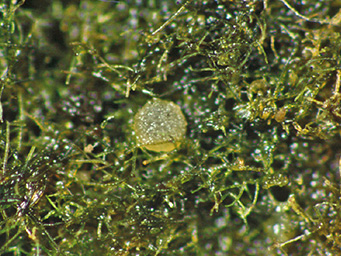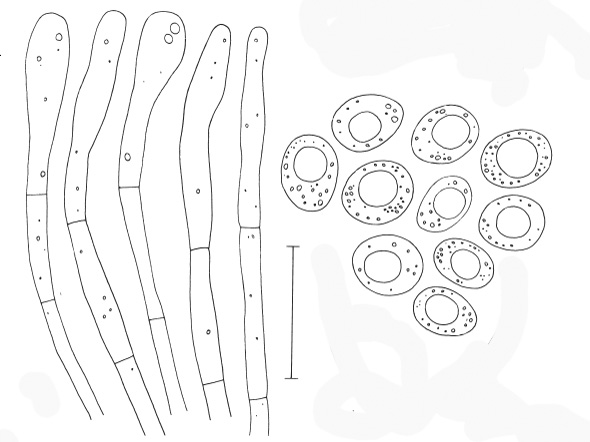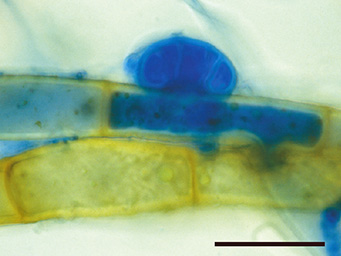|
Octospora mnii Döbbeler & Facher
Karstenia 54: 50 (2014)
|

| 
|
| 1: Octospora mnii, apothecium in protonema of Rhizomnium punctatum, image by Döbbeler & Facher |
2: Octospora mnii, spores, image by Döbbeler & Facher |

Apothecia: 0.3-0.6 mm long and 0.2-0.6 mm wide, first barrel-shaped later forming a flat rimless disc, colourless to yellowish
Paraphyses: filamentous, not ramified, apically slightly widened to 5–8 µm
Asci: 150–230 x (13–)15–19(–22) µm, 8-spored, spores uniseriate
Ascospores: subglobose to ovoide or broadly ellipsoid, (13-)14-17(-19) x (9.5-)10-13(-14) µm, colourless, with one large, globose droplet, epispore delicately rough and cyanophilous
Host: Rhizomnium punctatum
Infectious structures: infects the persistent protonema, appressoria 25–50 µm long, 10–27 µm high and 21–26 µm wide, 1-2(-3) septate
Habitat: on decaying logs in shaded situations, growing in the dense, persistend protonema of Rhizomnium punctatum
Distribution: Austria (Friebes et al. 2024), Germany (BY)

References:
- Döbbeler, P. & Facher, E. 2014. Octospora mnii (Pezizales), a new ascomycete on the persistent protonema of Rhizomnium punctatum. - Karstenia 54: 49-56.
- Friebes G., Janošík L., Pöltl M. & Gallé A. 2024. Neue Nachweise bryoparasitischer Pilze in der Steiermark (Österreich). - Joannea Botanik 20: 49–79. PDF
- Janošík, L., Sochorová, Z., Eckstein, J., Vega, M. & Koukol, O. 2023. Ascospore morphology of bryophilous Pezizales is closely associated with the place of infection and host ecology. - Fungal Ecology 61: 101200. DOI
|
| Images:
|
 |
 |
| 3: Octospora mnii, appressorium on protonemal filament, image by Döbbeler & Facher |
4: Octospora mnii, infectious structure, image by Döbbeler & Facher |

|
|



